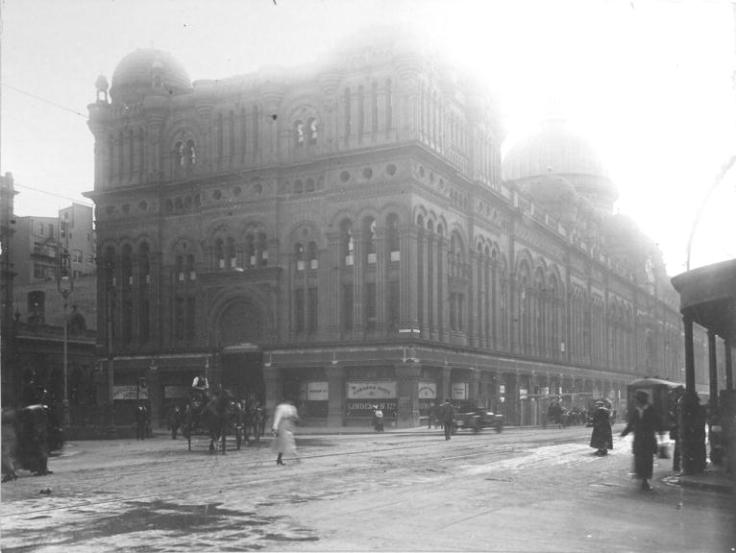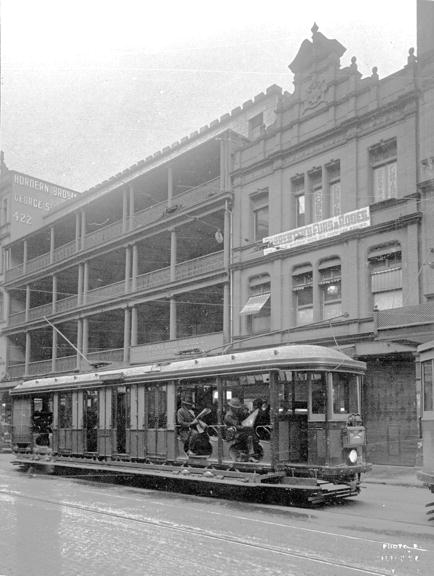George Street is regarded as Sydney’s first street. Some think that it follows the alignment of an earlier Aboriginal pathway; for others, this thoroughfare was formed by virtue of the topography at Sydney Cove. It was very possibly a combination of the two. One of the earlier European names it was called by was High Street, following the English tradition of naming main streets. It was officially named George Street in 1810 by Governor Lachlan Macquarie in honour of the monarch, King George III.
George Street soon became Sydney’s main thoroughfare, connecting up to the road west to Parramatta by the early 1800s. By the mid to late-19th century, horse drawn carriages and carts jostled for space with steam and horse-driven trams, as well as pedestrians and bicycles. But it was the arrival of the electric tram that shook things up. Plans to introduce electric trams along George Street, between Redfern Railway Station and Circular Quay, were first mooted in 1896.

The proposal was greeted with dismay from some quarters, mainly due to the need to erect poles to carry the overhead wiring, as outlined in an editorial in the Bowral Free Press and Berrima District Intelligencer in March 1896:
Sydney has always been proud of George Street. There is a distinctive peculiarity about this great thoroughfare that appeals to the national sense of the average citizen. With the exception of Macquarie-street north, it is the one spacious thoroughfare the city boasts. The news that the tram fiend is to invade it comes as a shock to many people and will make a serious difference to the omnibus proprietors.
After around two years of deliberation and delays in getting the correct equipment, the NSW Department of Public Works began constructing the electric tramline in April 1898. It was to run along George Street, but also along Harris Street to Pyrmont and Ultimo. An integral part of the new electric tramline for Sydney was the Ultimo Powerhouse, which provided the electricity to power it.
The first trial run of the new tram on Harris Street took place on Thursday 5 October 1899. It was heralded as a success. The NSW Governor, Lord Beauchamp, took a test run a few weeks later.
On 6 December 1899, the new electric tramline was handed over to the Railway Commissioners and it was opened to the public two days later.

NSCA CRS 51/1247)
According to Isadore Brodsky, ‘…those trams, live true love, never did run smooth’ (Streets of Sydney). On its first day, a small child was killed by an electric tram near the Manly Wharf, although the driver was later exonerated. And there were ongoing ‘minor skirmishes between tram drivers and horse bus drivers’ because the latter felt their livelihoods under threat and so ‘obstructed the trams whenever they could’. The trams also had a habit of rocking back and forwards, and the wheels regularly slipped on the rails. But for passengers, the new trams provided a faster and cheaper route into the city and were taken up with gusto
A few years after the electric tram along George Street was stopped, Isadore Brodsky commented in the Streets of Sydney that:
It must be a case-hardened citizen who cannot see how much the George Street trams contributed to the progress and comfort, night and day, when the town was blossoming into a city.
Although the George Street tram was closed for business in November 1958, it lives to see another day.
October 13, 2015 at 11:22 pm
Sydney had the absolute right to be proud of George Street, a spacious street in a city that was not, generally speaking, pre-planned. But the news that the “tram fiend” was to “invade” George St should not have come as a shock to the good citizens of Sydney. Certainly the omnibus proprietors might have been getting their knickers in a knot, but the sight of a tram gliding majestically down George St would have _enhanced_ a proud thoroughfare.
July 18, 2016 at 10:16 am
I’ve just discovered your site … what a terrific idea. I’m now a fan. Having edited a few books on Sydney’s history (GPO, Luna Park) I know how difficult it is to precisely identifty some locations (ie, cross streets etc) but I’m wondering if you know which section of George Street the tram photo was taken (George Street electric tram in 1926 (City of Sydney Archives). I’m trying to figure out the name of the building (a hotel) with the multiple verandahs.
Thanks!
Phil Rodwell
July 22, 2016 at 10:13 pm
Hi Phil, ta for the nice words! I just checked the City Archives catalogue record & the building is the original Dymocks (known as The Block) – address is given as 424-30 George St.